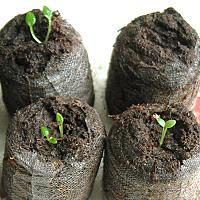


| Return to Asiatic Species List | Return to Species cover page | Return to Home Page |
D. semibarbatum (syn zalil)
Plant Development from Seed to Flowering
This yellow flowered delphinium is found on dry semidesert slopes in the foothills and lower mountain zone in Iran, Afghanistan and adjoining countries of central Asia.
The eyes of the world focussed on Afghanistan during the conflict that followed the terrible events in America in September 2001. The general picture was of a barren land plagued by drought and it is hard to imagine that it could possibly be home to one of the loveliest wild delphiniums, the yellow-flowered D. zalil. In the Delphinium Society Year Book for 1966, Paul Furse reported finding this species in Afghanistan on the northern foothills of the Paropamisus mountains north of Herat in the west of the country and also in the far north-east on limestone hills in Badakshan, which is a narrow tongue of land between the mountains of the Hindu Kush and the Pamir Alai to the north. In this mountainous location, "the flowers were every shade of yellow from sulphur, to apricot gold, with the most luxuriant plants in folds and gullies which had a trace of moisture".
Seeds of the yellow-flowered delphinium species D. zalil, (D. semibarbatum is the botanically correct name) were available from Sutton's Seeds during 2002 in the fancy packaging of their "Plant Explorer" range. This challenges gardeners to try unusual plants and supplies 6 compressed peat discs to sow the seeds in. Following the instructions supplied, 2 seeds were sown in the top of each disc after thoroughly wetting the peat. The tray containing the peat discs was then put into a plastic bag and placed in a refrigerator. The first signs of germination were seen after about three weeks in the refrigerator.The package was then moved to warmer conditions and placed in good light. The seedlings developed normally, with the first true leaves present three weeks after the cotyledon stage, as seen in the first two pictures below.
 |
 |
 |
After potting up and transfer to a cold frame outdoors, the seedlings grew slowly and made obvious progress only after soaking by heavy rain. Hot sunny days scorched the foliage and the plants looked to be about to lapse into dormancy. This type of behaviour is a common problem with tuberous rooted delphinium species from arid regions. The seedlings were then planted in the garden in a position partially shaded by other large delphiniums, where the soil would remain moist. The seedlings made good progress after planting out and developed large basal leaves, as seen in the right hand picture above taken in late June.
With day temperatures above 20C after a period of wet weather, the plants developed rapidly during July. All seedlings developed flower stems, with the largest reaching 45cm (18in) tall after three weeks, with clear signs of a flower spike at the growth point.
 |
 |
 |
The developing blooms became infested with black aphids, as seen in the middle picture above. Such infestation of delphiniums with aphids is unusual but was readily controlled by spraying with insecticide. The plants were also severely affected by mildew. This was controlled but not eradicated by repeated spraying with a systemic fungicide. August was warm and without recorded rainfall from 10th August onwards. The flowers developed only slowly and any drying out of the soil led to immediate foliage browning. It was necessary to water the ground almost daily to avoid the plants becoming dormant. The first flower, right hand picture above, opened on 6th September after a shower of rain ended the dry spell.
The pale yellow flowers of the first bloom opened quickly and were soon followed by others. The flower stems, which grew to 90cm, were extensively branched. Some plants also developed one or two extra blooms from the base of their first stem. Flowering continued throughout September and October until wet weather ruined the plants. The flowers showed significant variations, with the yellow sepals being narrow for some plants but much broader in others, as seen in the pictures below.
 |
 |
 |
| Return to Asiatic Species List | Return to Species cover page | Return to Home Page |